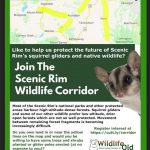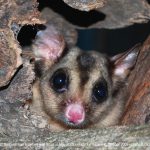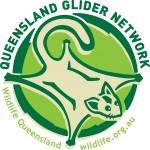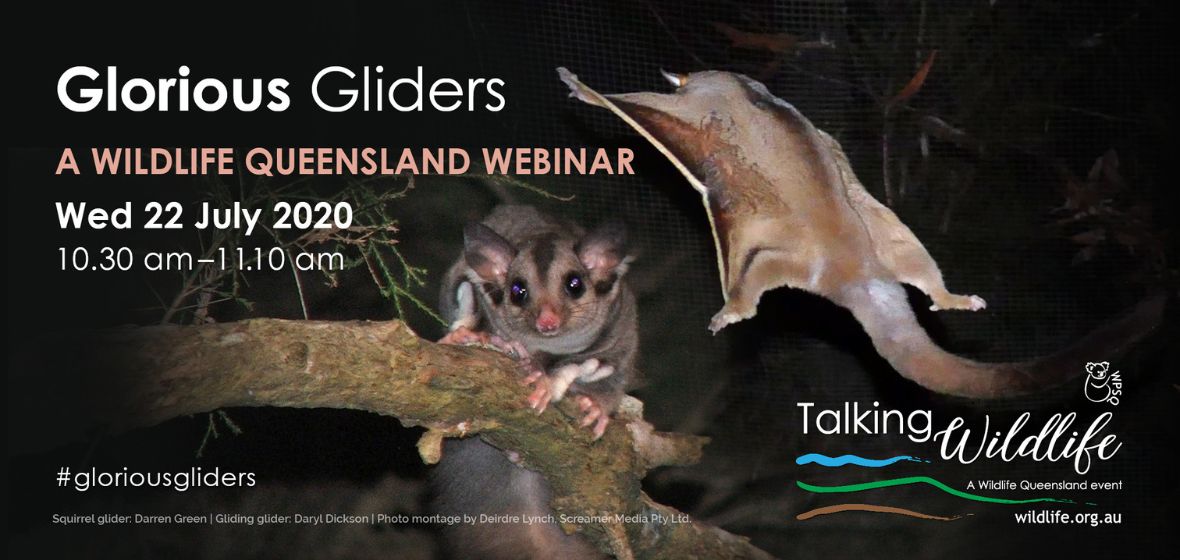About the event
Australia’s gliding possums are an amazing collection of species all renowned for being able to glide between trees with the aid of a membrane of skin linking the fore and hind legs.
They range in size from the tiny feathertail glider, which can sit in a child’s hand, to the solitary nationally and regionally vulnerable greater glider.
In this special webinar, you’ll learn about these amazing marsupials, their habitat and the main threats to glider populations.
You’ll also find out how Wildlife Queensland and its dedicated Queensland Glider Network are working to support glider populations through:
- the establishment of wildlife corridors
- data collection and mapping
- education initiatives
– and how you can help.
Click here to view the full webinar recording
Thank you to our presenters and attendees
Thank you for attending our Glorious Gliders webinar. We hope you enjoyed the event. Below you’ll find:
- PowerPoint presentations to download
- additional Q&As not recorded in the webinar
- full webinar recording
- information about how you can get involved with the presenters’ projects
- further information about gliders and the Queensland Glider Network.
Presentations
Glider Surveys and Corridors Project
Dr Ronda Green
- Download [5.74 MB] part 1 of the PowerPoint presentation
- Download [2.92 MB] part 2 of the PowerPoint presentation
Connecting and Protecting Queensland’s Endangered Mahogany Glider
Daryl Dickson
Webinar recording
Q&As
Below you’ll find our presenters’ responses to questions (in addition to those answered in the live webinar) that were sent through by attendees during the webinar.
Q. Do all glider species pair for life?
A. It depends on the species. Mahogany gliders pair for life. If a partner is lost no doubt they seek another but I am not sure what the situation is with the others. We may have to do some research to see what information is available for the other species.
Q. Although not covered, do either of the amazing presenters know anyone with expertise on the greater glider? We are producing a film on this species with the Qld Government soon and wondered if anyone in the Wildlife Queensland team might have a lead?
A. Yes. Wildlife Queensland projects manager Matt Cecil and our Queensland Glider Network (QGN) run a greater glider nest box project to help greater gliders in the Moreton Bay region. Thanks to recently awarded funding under the Moreton Bay Regional Council community grants program, Matt and members of the QGN will soon be installing nest boxes in Sheep Station Creek Conservation Park in Caboolture, Queensland, creating essential hollow shelters for this vulnerable species. The project also includes nest box monitoring surveys. We will be providing an update on this project in our free e-bulletin soon.
Q. How do you spell the tissue ?pretagion??
A. The flying membrane is called a patagium.
Q. Thank you for the presentation. I have one question. What are the main differences between mahogany and squirrel?
A. They vary in size significantly and in behaviour. If you get a chance to take a look at our presentation you will see slides that give quite a bit of detail about these differences.
Q. Will gliders have parasites problems?
A. Yes, mahogany gliders can suffer from parasite health issues. If they are short of dens they can have problems with mites that build up through having to remain in one den for an extended period of time. Some may cause an increase in blood parasites that can cause anemia but at this stage, I don’t know if studies have been done on the effects of parasites on any specific glider species.
Q. Is it possible then to plant more flora species in their habitat resulting in reducing the 20-hectare habitat requirements, then not having to travel so far?
A. That’s an interesting question. In the last decade, we have had some wonderful science completed that evaluates the quality of the habitat available to the mahogany glider and it turns out that not all habitat is equal. There is quite a bit of interest in looking at how we might enrich habitats to make them more viable for gliders. But as with all ideas, it isn’t as easy as just planting trees. Hopefully, this will be looked at in the next layer of research.
Q. I have sugar gliders living in a Telstra box on the ground… is this normal behaviour?
A. Yes, they are sometimes funny chaps. They are quite often found in cable pits. We had one group in our enclosure being prepared for release that decided to climb down into a hollow log that was partially buried … it took us a little while to work out why. The answer was that the ground was warmer than the air temp, and if you can’t find a well-insulated den when it’s cold you can you go to ground. Feathertail gliders are also found in strange places from time to time.
Q. It would be wonderful if there was a wildlife carer course available online. Does anyone know if any course may be available, please?
A. Yes, the Rescue and Immediate Care Course (RICC) is available online.
About the presenters
Matt Cecil, Projects Manager, Wildlife Queensland
Matt Cecil is the host.
Ronda Green, BSc(Hons) PhD
 Ronda J Green is an adjunct research fellow at Griffith University, her main research involving seed dispersal by frugivores and effects of habitat alteration on wildlife.
Ronda J Green is an adjunct research fellow at Griffith University, her main research involving seed dispersal by frugivores and effects of habitat alteration on wildlife.
Her lectureships have included population ecology, community ecology, conservation biology, nature/wildlife tourism, nature activities for primary teachers, and social biology.
She is chair of the Scenic Rim branch of Wildlife Queensland, has organised workshops and expos, a Bioblitz on Tamborine Mountain and surveys for gliders, and currently conducting a project on wildlife corridors focussing on squirrel glider habitat.
She runs Araucaria Ecotours, specialising in educational wildlife tours, is chair of Wildlife Tourism Australia Inc., and has authored and co-authored reports for the Sustainable Tourism CRC and a report for UNWTO on sustainable wildlife tourism in Asia and the Pacific, and published a wildlife tourism handbook.
She will soon publish the book, Understanding Australia’s Wildlife.
Daryl Dickson, Wildlife Artist and Conservationist
 Daryl is a member of the Wildlife Artist Society of Australasia, Queensland Wildlife Art Society, Birdlife Australia and the Wildlife Preservation Society Queensland.
Daryl is a member of the Wildlife Artist Society of Australasia, Queensland Wildlife Art Society, Birdlife Australia and the Wildlife Preservation Society Queensland.
Her passion for Australian wildlife is evident in her artwork depicting the fine detail of Australia’s beautiful and unique flora and fauna. She divides her time between art, conservation, wildlife rehabilitation and sharing her passion for the natural environment.
Daryl has been an active member of the National Mahogany Glider Recovery Team since the mid-1990s and is at present the President of the Cassowary Coast Hinchinbrook Branch of Wildlife Queensland.
She has spent much of the last three decades working with the conservation of the endangered mahogany glider. The conservation of this beautiful threatened gliding possum and its limited remaining woodland habitat in tropical north Queensland is the inspiration for her art and life.
She has also illustrated three beautiful children’s books:
- Glissandra the Glider
- Hull River Rolley
- Paddy O’Melon the Irish Kangaroo.
Daryl’s latest book is Celebrating Australia’s Magnificent Wildlife: The Art of Daryl Dickson. It will be in the Wildlife Queensland online store and all good bookstores worldwide from October 2020.
How to support our glider projects
 Join the Scenic Rim Wildlife Corridor Project
Join the Scenic Rim Wildlife Corridor Project
Help us protect the future of Scenic Rim’s squirrel gliders and native wildlife.
Head to our website for full details or email us at scenicrim@wildlife.org.au
 Help connect and protect Queensland’s endangered mahogany glider
Help connect and protect Queensland’s endangered mahogany glider
Help us protect the future of Queensland’s endangered mahogany glider.
Head to the Wildlife Queensland Cassowary Coast Hinchinbrook Branch and Wildlife Queensland Townsville Branch websites for more information.
Follow us on Facebook @Wildlife Queensland Cassowary Coast – Hinchinbrook
 Support Wildlife Queensland’s dedicated Queensland Glider Network
Support Wildlife Queensland’s dedicated Queensland Glider Network
- Find out about Wildlife Queensland’s dedicated Queensland Glider Network and how you can get involved.
- If you would like to make a financial contribution, you can support our work to protect and conserve gliders in the following ways:
- through our adopt-a-glider program
- buy some of our great glider merchandise online at the Wildlife Queensland shop.
- make a tax-deductible donation.
More information
- Subscribe to our FREE e-bulletin for all the latest wildlife project and campaign news.
- Glider species profiles
Contact us
If you have any questions or would like more information, please get in touch with Wildlife Queensland on 07 3844 0129 or email: communications@wildlife.org.au

